Effect of Hopcalite Modification on the Pore Textural and HCl Adsorption Properties of Activated Carbon Fibers
Abstract
1. Introduction
2. Materials and Methods
2.1. Materials
2.2. Preparation of Hopcalite-Modified ACFs
2.3. HCl Gas Adsorption
2.4. Characterization of Hopcalite-Modified ACFs
3. Results and Discussion
3.1. Morphology of Hopcalite-Modified ACFs
3.2. Elemental Analysis of Hopcalite-Modified ACFs
3.3. Specific Surface Area of the Hopcalite-Modified ACFs
3.4. HCl Gas Adsorption Properties
4. Conclusions
Author Contributions
Funding
Institutional Review Board Statement
Informed Consent Statement
Data Availability Statement
Conflicts of Interest
References
- Bal, M.; Reddy, T.T.; Meikap, B.C. Removal of HCl gas from off gases using self-priming venturi scrubber. J. Hazard. Mater. 2019, 364, 406–418. [Google Scholar] [CrossRef] [PubMed]
- Kim, K.D.; Jeon, S.M.; Hasolli, N.; Lee, K.S.; Lee, J.R.; Han, J.W.; Kim, H.T.; Park, Y.O. HCl removal characteristics of calcium hydroxide at the dry-type sorbent reaction accelerator using municipal waste incinerator flue gas at a real site. Korean J. Chem. Eng. 2017, 34, 747–756. [Google Scholar] [CrossRef]
- Xiao, H.; Song, Y.; Chen, J.; Ma, H.; Wang, L.; Xiang, Y.; Shao, L. Integrated high-gravity process for HCl removal and CO2 capture using carbide slag slurry in a rotor-stator reactor: Experimental and modeling studies. Chemosphere 2023, 340, 139848. [Google Scholar] [CrossRef] [PubMed]
- Wang, Z.; Jin, H.; Wang, K.; Xie, Y.; Ning, J.; Tu, Y.; Chen, Y.; Liu, H.; Zeng, H. A two-step method for the integrated removal of HCl, SO2 and NO at low temperature using viscose-based activated carbon fibers modified by nitric acid. Fuel 2019, 239, 272–281. [Google Scholar] [CrossRef]
- Colunga Biancatelli, R.M.; Solopov, P.; Dimitropoulou, C.; Catravas, J.D. Age-dependent chronic lung injury and pulmonary fibrosis following single exposure to hydrochloric acid. Int. J. Mol. Sci. 2021, 22, 8833. [Google Scholar] [CrossRef] [PubMed]
- Olivas-Ogaz, M.A.; Eklund, J.; Svensson, J.E.; Liske, J.; Jonsson, T. Microstructural study of the influence of KCl and HCl on preformed corrosion product layers on stainless steel. Oxid. Met. 2017, 87, 801–811. [Google Scholar] [CrossRef]
- Hadi, P.; Yeung, K.Y.; Barford, J.; An, K.J.; McKay, G. Significance of “effective” surface area of activated carbons on elucidating the adsorption mechanism of large dye molecules. J. Environ. Chem. Eng. 2015, 3, 1029–1037. [Google Scholar] [CrossRef]
- Zhu, L.; Shen, D.; Luo, K.H. A critical review on VOCs adsorption by different porous materials: Species, mechanisms and modification methods. J. Hazard. Mater. 2020, 389, 122102. [Google Scholar] [CrossRef]
- Hassan, M.F.; Sabri, M.A.; Fazal, H.; Hafeez, A.; Shezad, N.; Hussain, M. Recent trends in activated carbon fibers production from various precursors and applications—A comparative review. J. Anal. Appl. Pyrolysis 2020, 145, 104715. [Google Scholar] [CrossRef]
- Wu, W.; Cheng, K.; Hu, Y.; He, H.; Wang, P.; Zhu, C. Adsorption and desorption mechanism of toluene gas by iron modified activated carbon fiber. Chem. Phys. 2024, 580, 112240. [Google Scholar] [CrossRef]
- Guo, Z.; Huang, J.; Xue, Z.; Wang, X. Electrospun graphene oxide/carbon composite nanofibers with well-developed mesoporous structure and their adsorption performance for benzene and butanone. Chem. Eng. J. 2016, 306, 99–106. [Google Scholar] [CrossRef]
- Maddah, B.; Nasouri, K. Fabrication of high surface area PAN-based activated carbon fibers using response surface methodology. Fibers Polym. 2015, 16, 2141–2147. [Google Scholar] [CrossRef]
- Kianfar, E.; Sayadi, H. Recent advances in properties and applications of nanoporous materials and porous carbons. Carbon Lett. 2022, 32, 1645–1669. [Google Scholar] [CrossRef]
- Abegunde, S.M.; Idowu, K.S.; Adejuwon, O.M.; Adeyemi-Adejolu, T. A review on the influence of chemical modification on the performance of adsorbents. Resour. Environ. Sustain. 2020, 1, 100001. [Google Scholar] [CrossRef]
- Aljamali, N.M.; Khdur, R.; Alfatlawi, I.O. Physical and chemical adsorption and its applications. Int. J. Thermodyn. Chem. Kinet. 2021, 7, 1–8. [Google Scholar] [CrossRef]
- Sharma, A.; Jindal, J.; Mittal, A.; Kumari, K.; Maken, S.; Kumar, N. Carbon materials as CO2 adsorbents: A review. Environ. Chem. Lett. 2021, 19, 875–910. [Google Scholar] [CrossRef]
- Summers, M.; Oh, J.; Lungu, C.T. Determination of activated carbon fiber adsorption capacity for several common organic vapors: Applications for respiratory protection. J. Air Waste Manag. Assoc. 2022, 72, 570–580. [Google Scholar] [CrossRef] [PubMed]
- Zhi, Y.; Liu, J. Adsorption of perfluoroalkyl acids by carbonaceous adsorbents: Effect of carbon surface chemistry. Environ. Pollut. 2015, 202, 168–176. [Google Scholar] [CrossRef]
- Ge, Y.; Akpinar, I.; Li, Z.; Liu, S.; Hua, J.; Li, W.; Zhao, T.; Hu, X. Porous structured cotton-based ACF for the adsorption of benzen. Chemosphere 2021, 282, 131110. [Google Scholar] [CrossRef]
- Bi, Y.; Sun, E.; Zhang, S.; Du, F.; Wei, H.; Liu, F.; Zhao, C. Synergistic effect of adsorption and photocatalysis for the degradation of toluene by TiO2 loaded on ACF modified by Zn (CH3COO)2. Environ. Sci. Pollut. Res. 2021, 28, 57398–57411. [Google Scholar] [CrossRef]
- Huang, Y.; Yu, Q.; Li, M.; Jin, S.; Fan, J.; Zhao, L.; Yao, Z. Surface modification of activated carbon fiber by low-temperature oxygen plasma: Textural property, surface chemistry, and the effect of water vapor adsorption. Chem. Eng. J. 2021, 418, 129474. [Google Scholar] [CrossRef]
- Gong, Y.; Wu, J.; Kitano, M.; Wang, J.; Ye, T.N.; Li, J.; Kobayashi, Y.; Kishida, K.; Abe, H.; Niwa, Y.; et al. Ternary intermetallic LaCoSi as a catalyst for N2 activation. Nat. Catal. 2018, 1, 178–185. [Google Scholar] [CrossRef]
- Shinde, P.S.; Suryawanshi, P.S.; Patil, K.K.; Belekar, V.M.; Sankpal, S.A.; Delekar, S.D.; Jadhav, S.A. A brief overview of recent progress in porous silica as catalyst supports. J. Compos. Sci. 2021, 5, 75. [Google Scholar] [CrossRef]
- Grant, J.T.; Venegas, J.M.; McDermott, W.P.; Hermans, I. Aerobic oxidations of light alkanes over solid metal oxide catalysts. Chem. Rev. 2017, 118, 2769–2815. [Google Scholar] [CrossRef] [PubMed]
- Dey, S.; Dhal, G.C. Synthesis of CuMnOx catalysts by novel routes for selective catalytic oxidation of carbon monoxide. Comput. Toxicol. 2020, 16, 100132. [Google Scholar] [CrossRef]
- Dey, S.; Dhal, G.C. Deactivation and regeneration of hopcalite catalyst for carbon monoxide oxidation: A review. Mater. Today Chem. 2019, 14, 100180. [Google Scholar] [CrossRef]
- Dey, S.; Dhal, G.C.; Mohan, D.; Prasad, R. Study of Hopcalite (CuMnOx) catalysts prepared through a novel route for the oxidation of carbon monoxide at low temperature. Bull. Chem. React. Eng. Catal. 2017, 12, 393–407. [Google Scholar] [CrossRef]
- Dey, S.; Dhal, G.C. Synthesis of Hopcalite catalysts by various methods for improved catalytic conversion of carbon monoxide. Mater. Sci. Energy Technol. 2020, 3, 377–389. [Google Scholar] [CrossRef]
- Dey, S.; Dhal, G.C. A review of synthesis, structure and applications in hopcalite catalysts for carbon monoxide oxidation. Aerosol Sci. Eng. 2019, 3, 97–131. [Google Scholar] [CrossRef]
- Dey, S.; Mehta, N.S. To optimized various parameters of Hopcalite catalysts in the synthetic processes for low temperature CO oxidation. Appl. Energy Combust. Sci. 2021, 6, 100031. [Google Scholar] [CrossRef]
- Afzal, S.; Quan, X.; Zhang, J. High surface area mesoporous nanocast LaMO3 (M=Mn, Fe) perovskites for efficient catalytic ozonation and an insight into probable catalytic mechanism. Appl. Catal. B Environ. 2017, 206, 692–703. [Google Scholar] [CrossRef]
- Yusuf, A.; Sun, Y.; Snape, C.; He, J.; Wang, C.; Ren, Y.; Jia, H. Low-temperature formaldehyde oxidation over manganese oxide catalysts: Potassium mediated lattice oxygen mobility. Mol. Catal. 2020, 497, 111204. [Google Scholar] [CrossRef]
- Dey, S.; Dhal, G.C. Ceria doped CuMnOx as carbon monoxide oxidation catalysts: Synthesis and their characterization. Surf. Interfaces 2020, 18, 100456. [Google Scholar] [CrossRef]
- Amrute, A.P.; Mondelli, C.; Hevia, M.A.; Pérez-Ramírez, J. Mechanism–performance relationships of metal oxides in catalyzed HCl oxidation. ACS Catal. 2011, 1, 583–590. [Google Scholar] [CrossRef]
- Tian, X.; Wang, S.; Wang, Z.J.; Wang, H.; Zhou, Y.; Zhong, H.; Mao, Y. Understanding the promotion effect of Mn on CuO/Al2O3 for catalyzed HCl oxidation to Cl2. ChemCatChem 2020, 12, 3240–3248. [Google Scholar] [CrossRef]
- Islam, M.A.; Rahman, M.M. Dissolution kinetics of colloidal manganese dioxide in aqueous hydrochloric acid at 298 K. Russ. J. Phys. Chem. A 2015, 89, 706–709. [Google Scholar] [CrossRef]
- Habbache, N.; Alane, N.; Djerad, S.; Tifouti, L. Leaching of copper oxide with different acid solutions. Chem. Eng. J. 2009, 152, 503–508. [Google Scholar] [CrossRef]
- Liu, Y.; Cheng, X.; Zhang, S. Hierarchically porous carbon derived from tobacco waste by one-step molten salt carbonization for supercapacitor. Carbon Lett. 2022, 32, 251–263. [Google Scholar] [CrossRef]
- Lee, D.; Kim, Y.; Kwon, O.H.; Park, W.H.; Cho, D. Carbon fiber coating with MWCNT in the presence of polyethyleneimine of different molecular weights and the effect on the interfacial shear strength of thermoplastic and thermosetting carbon fiber composites. Carbon Lett. 2021, 31, 407–417. [Google Scholar] [CrossRef]
- Stella, V.; Dhanaprabhu, P.; Rajendra, K.R.T.; Yuvaraj, H. Heteroatom-doped mesoporous carbon prepared from a covalent organic framework. Carbon Lett. 2021, 31, 1309–1316. [Google Scholar] [CrossRef]
- Wang, S.; Kou, T.; Varley, J.B.; Akhade, S.A.; Weitzner, S.E.; Baker, S.E.; Duoss, E.B.; Li, Y. Cu2O/CuS nanocomposites show excellent selectivity and stability for formate generation via electrochemical reduction of carbon dioxide. ACS Mater. Lett. 2020, 3, 100–109. [Google Scholar] [CrossRef]
- Shao, L.; Sun, A.; Zhang, Y.; Yu, L.; Suo, N.; Zuo, Z. Microstructure, XPS and magnetic analysis of Al-doped nickel–manganese–cobalt ferrite. J. Mater. Sci. Mater. Electron. 2021, 32, 20474–20488. [Google Scholar] [CrossRef]
- Ono, Y. Structural analysis of NaCuO2 cathode at various charged/discharged stages and its reaction mechanism. Electrochemistry 2018, 86, 309–314. [Google Scholar] [CrossRef]
- Tabassum, S.; Yamasue, E.; Okumura, H.; Ishihara, K.N. Electrical stability of Al-doped ZnO transparent electrode prepared by sol-gel method. Appl. Surf. Sci. 2016, 377, 355–360. [Google Scholar] [CrossRef]
- Boparai, H.K.; El-Sharnouby, O.; O’Carroll, D.M. Catalytic dechlorination of 1, 2-DCA in nano Cu0-borohydride system: Effects of Cu0/Cun+ ratio, surface poisoning, and regeneration of Cu0 sites. Sci. Rep. 2023, 13, 11883. [Google Scholar] [CrossRef]
- Kim, M.J.; Kim, K.H.; Kim, Y.; Yoo, B.; Lee, Y.S. Volatile organic compounds (VOCs) removal using ACFs with electroless plating CuO as catalysts. Carbon Lett. 2020, 30, 675–682. [Google Scholar] [CrossRef]
- Vijayaraghavan, K.; Jegan, J.; Palanivelu, K.; Velan, M. Batch and column removal of copper from aqueous solution using a brown marine alga Turbinaria ornata. Chem. Eng. J. 2005, 106, 177–184. [Google Scholar] [CrossRef]
- Aksu, Z.; Gönen, F. Biosorption of phenol by immobilized activated sludge in a continuous packed bed: Prediction of breakthrough curves. Process Biochem. 2004, 39, 599–613. [Google Scholar] [CrossRef]
- Hasan, S.H.; Srivastava, P.; Talat, M. Biosorption of lead using immobilized Aeromonas hydrophila biomass in up flow column system: Factorial design for process optimization. J. Hazard. Mater. 2010, 177, 312–322. [Google Scholar] [CrossRef]
- Futalan, C.M.; Kan, C.C.; Dalida, M.L.; Pascua, C.; Wan, M.W. Fixed-bed column studies on the removal of copper using chitosan immobilized on bentonite. Carbohydr. Polym. 2011, 83, 697–704. [Google Scholar] [CrossRef]
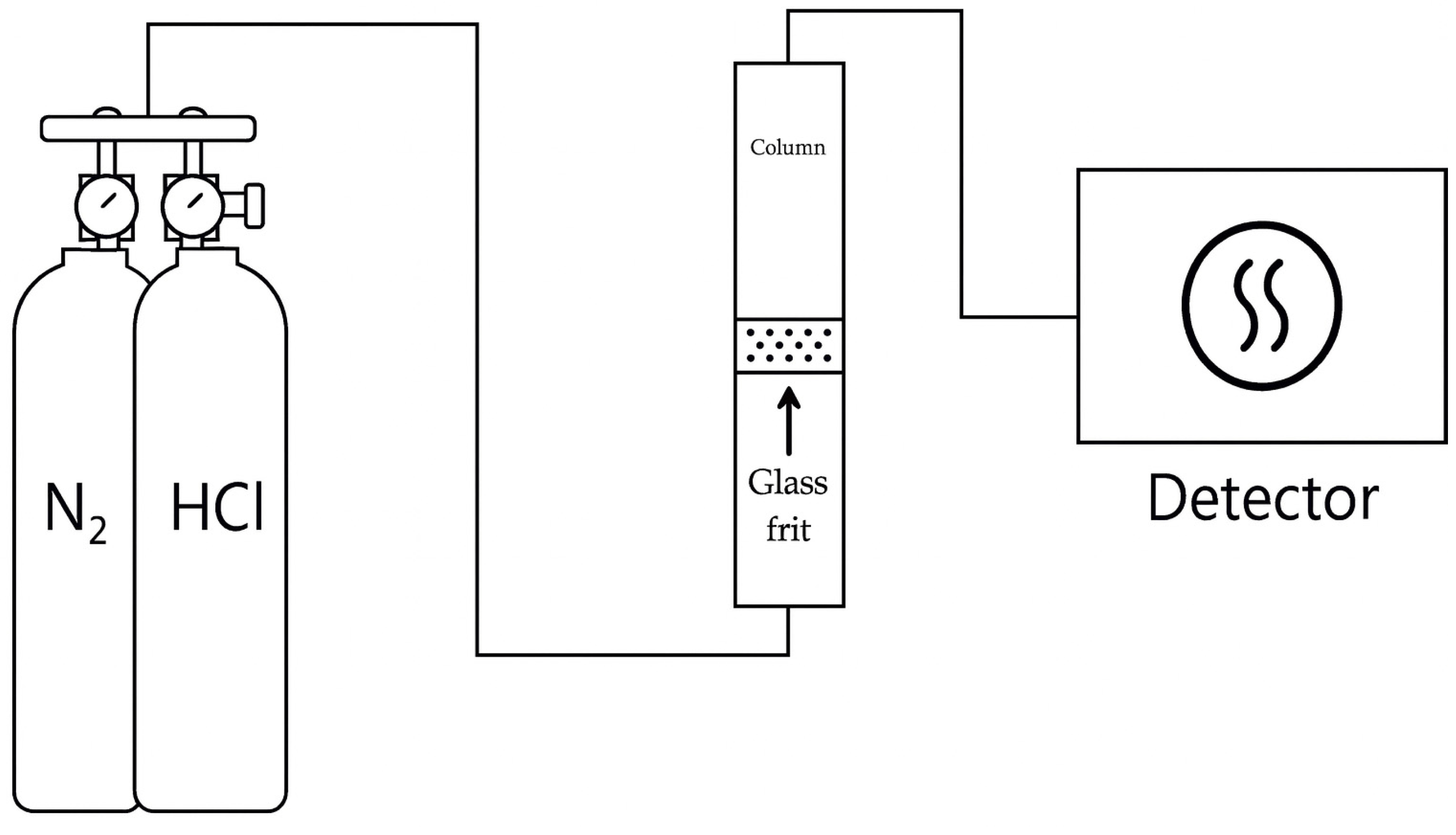

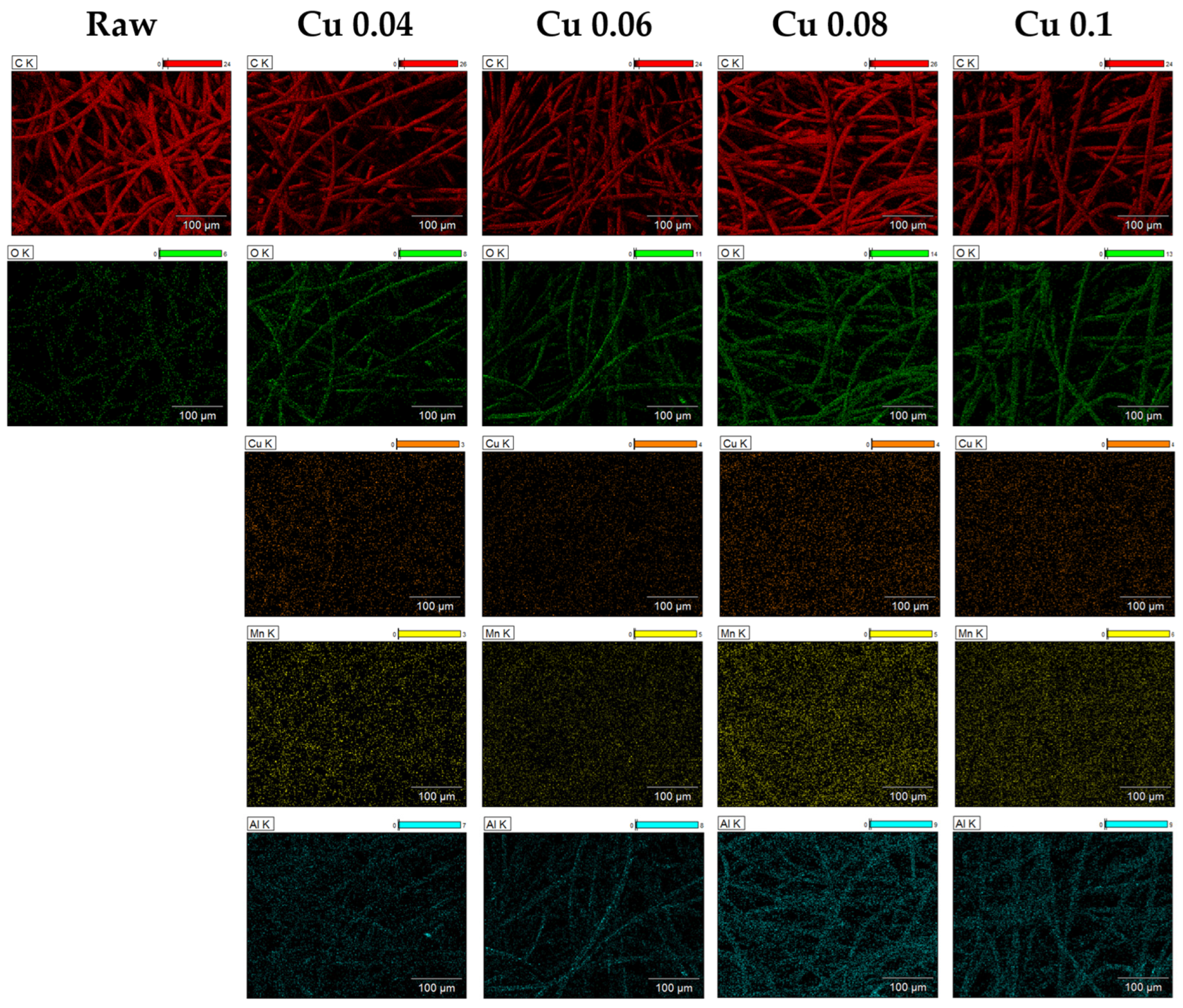
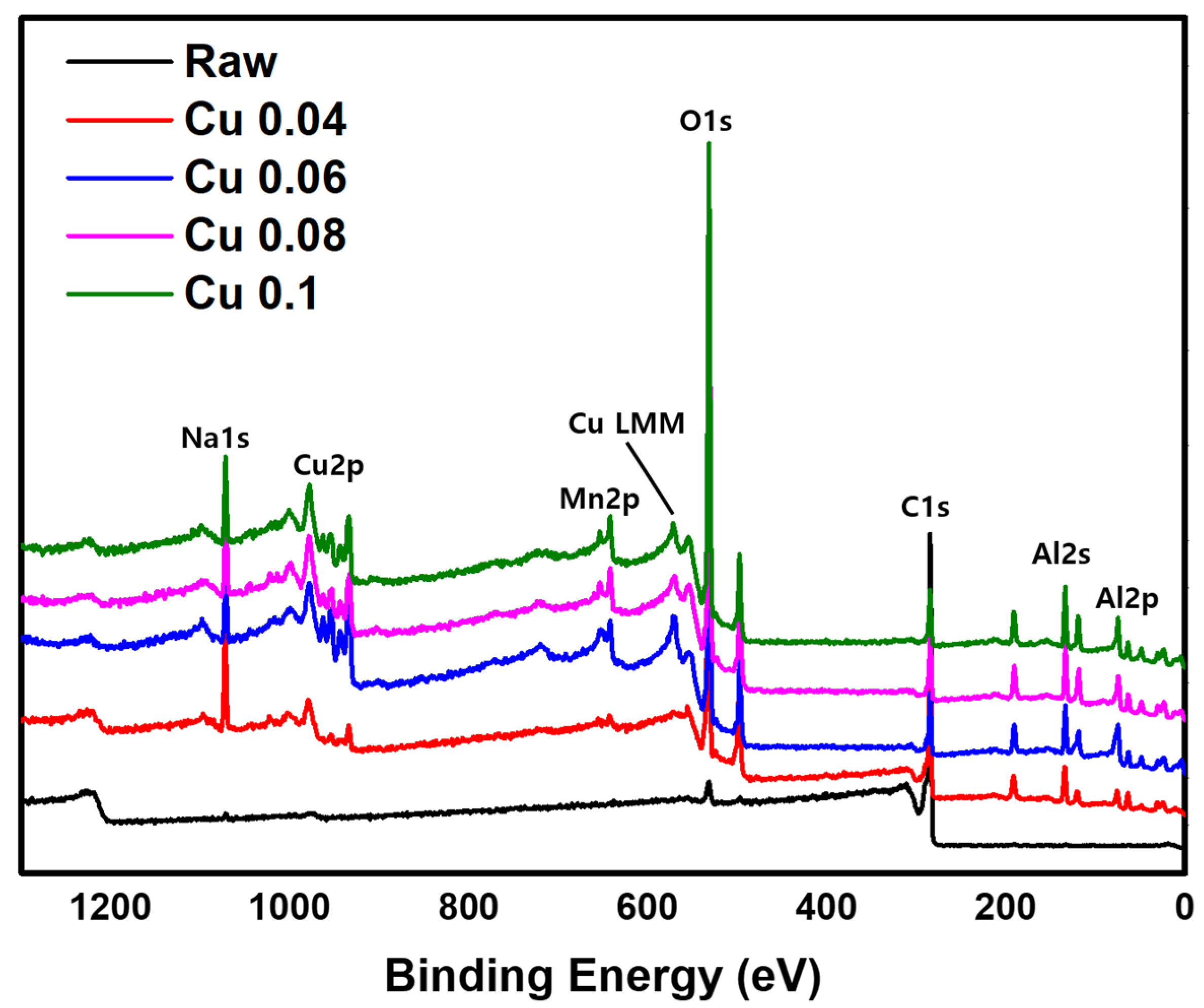
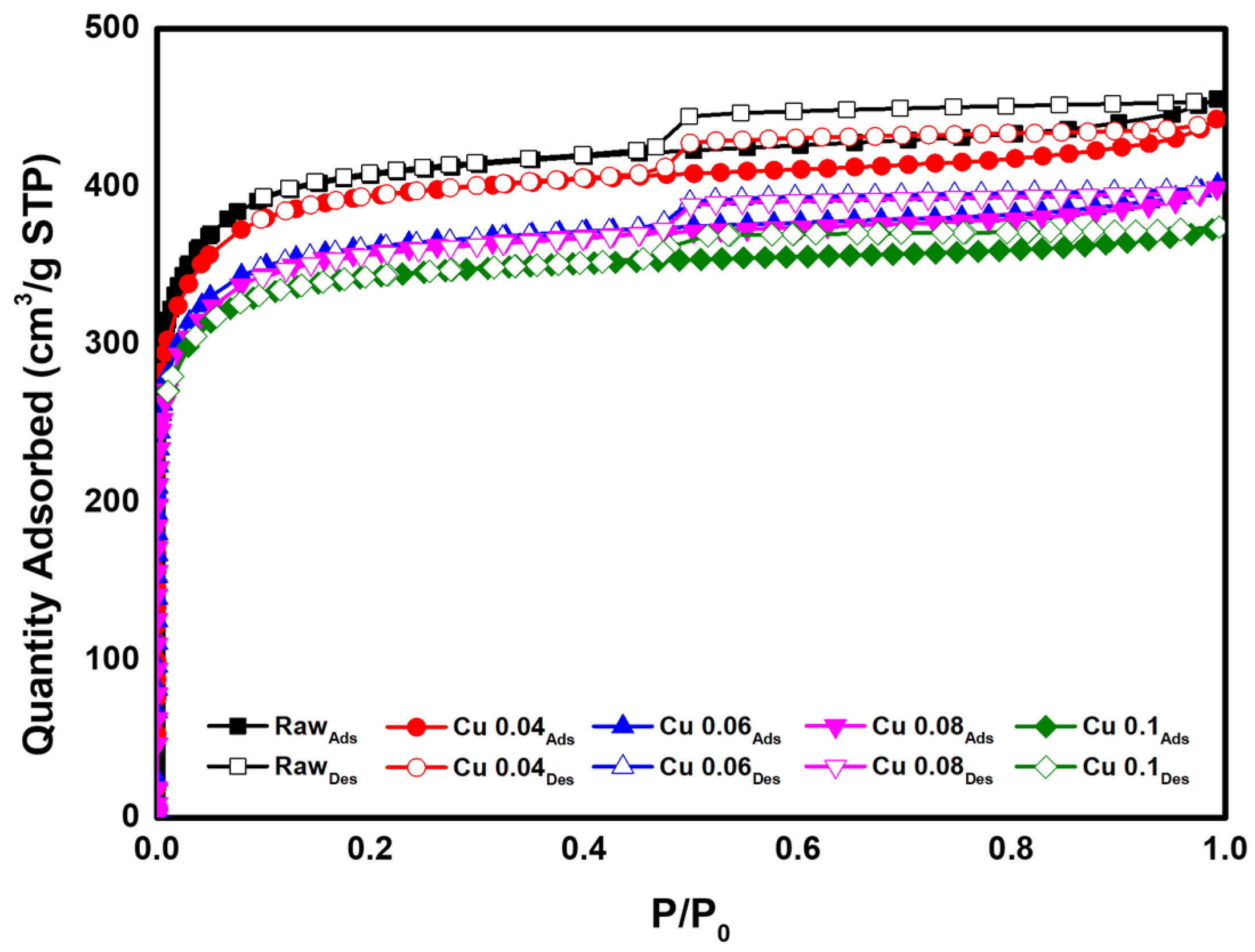
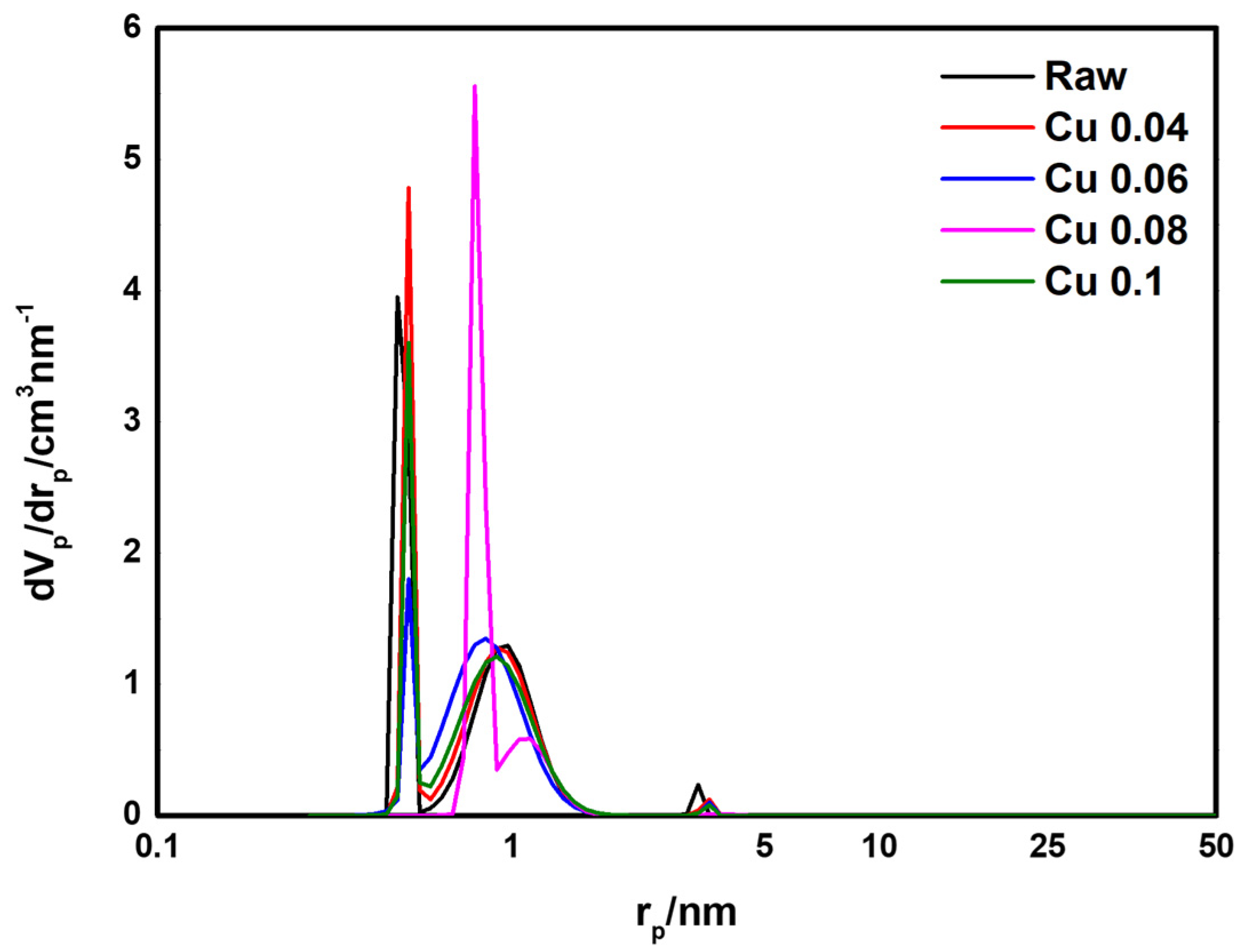
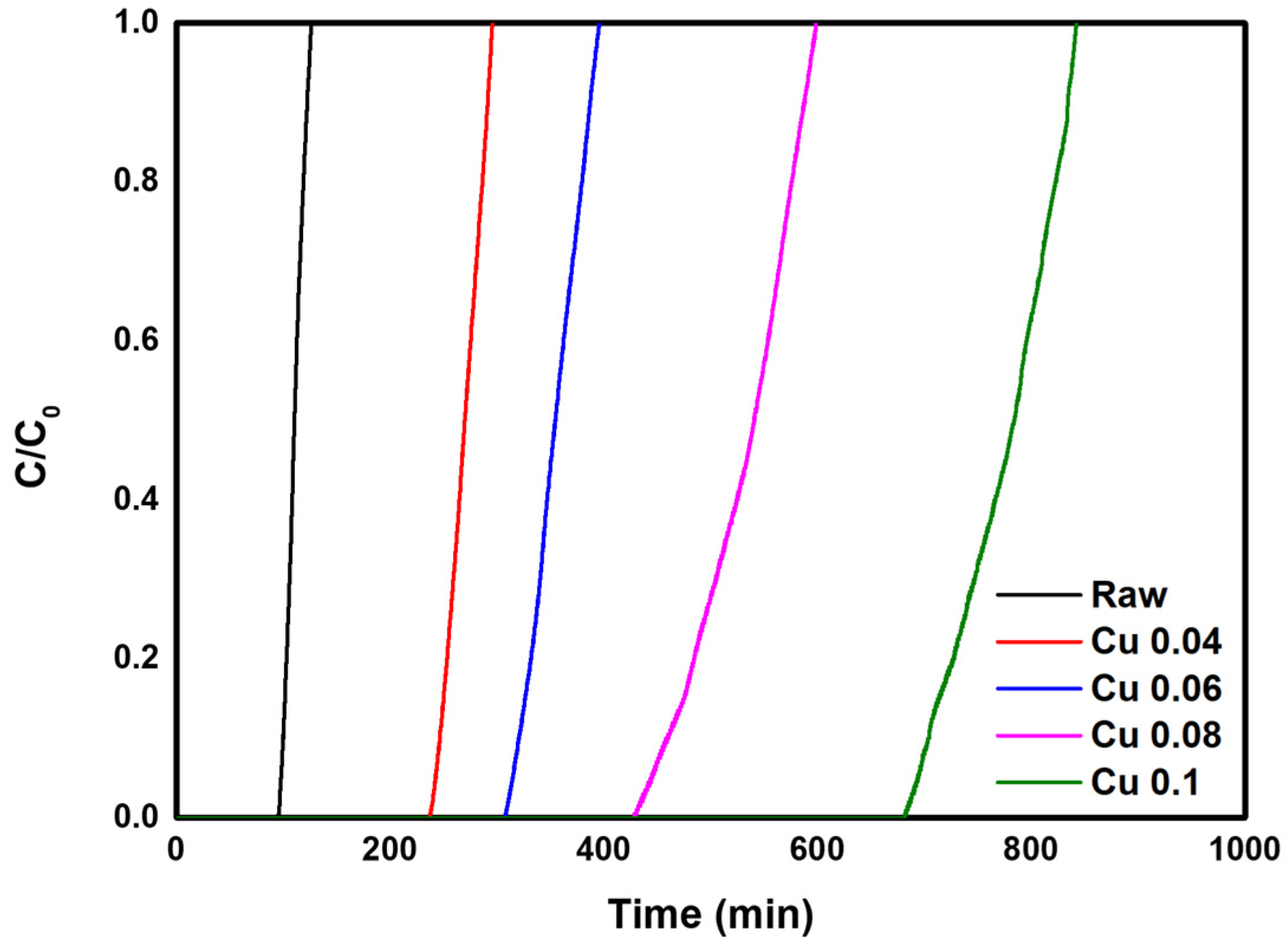
| Atomic (%) | |||||
|---|---|---|---|---|---|
| Raw | Cu 0.04 | Cu 0.06 | Cu 0.08 | Cu 0.1 | |
| C (%) | 95.31 | 82.34 | 76.93 | 74.56 | 70.18 |
| O (%) | 4.69 | 13.45 | 16.80 | 18.24 | 20.25 |
| Cu (%) | 0 | 2.22 | 2.65 | 2.90 | 3.98 |
| Mn (%) | 0 | 1.19 | 2.29 | 2.72 | 3.66 |
| Al (%) | 0 | 0.80 | 1.33 | 1.58 | 1.93 |
| Raw | Cu 0.04 | Cu 0.06 | Cu 0.08 | Cu 0.1 | |
|---|---|---|---|---|---|
| Cu (ppm) | 163.13 | 10,318.37 | 25,849.31 | 30,582.99 | 46,057.65 |
| Mn (ppm) | 155.84 | 5038.85 | 9697.20 | 19,828.92 | 32,293.23 |
| Sample | SBET (m2/g) | Total Pore Volume (cm3/g) | Micropore Volume (cm3/g) | Microporosity (%) |
|---|---|---|---|---|
| Raw | 1565.1 | 0.70 | 0.67 | 95.71 |
| Cu 0.04 | 1507.2 | 0.68 | 0.65 | 95.59 |
| Cu 0.06 | 1386.3 | 0.62 | 0.60 | 96.77 |
| Cu 0.08 | 1367.8 | 0.61 | 0.59 | 96.72 |
| Cu 0.1 | 1342.7 | 0.58 | 0.53 | 91.38 |
| Sample Name | Superficial Velocity | Initial Concentration | Bed Height | Total Time | Breakthrough Time | Saturation Time | Effluent Volume | Total Amount Removed | Total Removal | Adsorption Capacity | Length of MTZ | Bed Utilization |
|---|---|---|---|---|---|---|---|---|---|---|---|---|
| Q | C0 | Z | ttotal | t0.05 | t0.95 | Veff | mtotal | Rtotal | qtotal | LMTZ | f | |
| (mL/min) | (mg/L) | (cm) | (min) | (min) | (min) | (cc) | (mg) | (%) | (mg/g) | (cm) | (%) | |
| Raw | 1000 | 50 | 2.5 | 125.8 | 97.6 | 124.1 | 125,816 | 6290.8 | 74.70 | 4699.3 | 0.53 | 89.34 |
| Cu 0.04 | 1000 | 50 | 2.5 | 295.5 | 242.3 | 293.3 | 295,450 | 14,772.5 | 83.63 | 12,354.6 | 0.44 | 91.29 |
| Cu 0.06 | 1000 | 50 | 2.5 | 395.7 | 314.2 | 391.1 | 395,660 | 19,783.0 | 70.28 | 13,903.6 | 0.49 | 90.17 |
| Cu 0.08 | 1000 | 50 | 2.5 | 598.6 | 443.6 | 593.2 | 598,600 | 29,930.0 | 65.11 | 19,488.3 | 0.63 | 87.39 |
| Cu 0.1 | 1000 | 50 | 2.5 | 842.2 | 693.2 | 838.3 | 842,200 | 42,110.0 | 62.84 | 26,460.3 | 0.43 | 91.35 |
Disclaimer/Publisher’s Note: The statements, opinions and data contained in all publications are solely those of the individual author(s) and contributor(s) and not of MDPI and/or the editor(s). MDPI and/or the editor(s) disclaim responsibility for any injury to people or property resulting from any ideas, methods, instructions or products referred to in the content. |
© 2025 by the authors. Licensee MDPI, Basel, Switzerland. This article is an open access article distributed under the terms and conditions of the Creative Commons Attribution (CC BY) license (https://creativecommons.org/licenses/by/4.0/).
Share and Cite
Han, M.S.; Bai, B.C. Effect of Hopcalite Modification on the Pore Textural and HCl Adsorption Properties of Activated Carbon Fibers. Materials 2025, 18, 4942. https://doi.org/10.3390/ma18214942
Han MS, Bai BC. Effect of Hopcalite Modification on the Pore Textural and HCl Adsorption Properties of Activated Carbon Fibers. Materials. 2025; 18(21):4942. https://doi.org/10.3390/ma18214942
Chicago/Turabian StyleHan, Min Seong, and Byong Chol Bai. 2025. "Effect of Hopcalite Modification on the Pore Textural and HCl Adsorption Properties of Activated Carbon Fibers" Materials 18, no. 21: 4942. https://doi.org/10.3390/ma18214942
APA StyleHan, M. S., & Bai, B. C. (2025). Effect of Hopcalite Modification on the Pore Textural and HCl Adsorption Properties of Activated Carbon Fibers. Materials, 18(21), 4942. https://doi.org/10.3390/ma18214942









